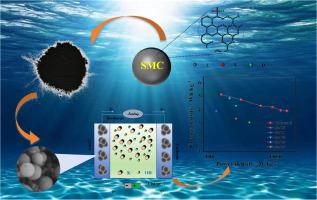Synthesis of S-doped mesoporous carbon and its use in advanced supercapacitors and sodium-ion batteries
IF 3.9
Q2 MATERIALS SCIENCE, MULTIDISCIPLINARY
引用次数: 0
Abstract
Rational design of mesoporous carbon materials with controllable pore structures and higher specific surface areas has always been a daunting challenge in advanced energy materials. Here, we propose a simple hydrothermal synthesis strategy for the preparation of sulfur-doped mesoporous carbon (SMC), which exhibits hierarchical porosity and a significantly increased specific surface area (650.22 m2 g-1). This structure is constructed through the molecular assembly of phenolic resin precursors with bifunctional sodium sulfate (simultaneously achieving sulfur doping and pore modulation), mediated by Pluronic F127 triblock copolymer as a mesostructure directing agent. System characterization indicates that the optimized SMC-0.1 material possesses excellent electrochemical properties: (1) as a supercapacitor electrode, it provides an outstanding specific capacitance of 188.9 F g-1 at 0.5 A g-1; (2) the fabricated symmetrical device (SMC-0.1//SMC-0.1) achieves an energy density of 5.12 Wh kg-1 at a power density of 150.07 W kg-1 in a 6 M KOH electrolyte; (3) when used as a sodium-ion battery anode, SMC-0.1 exhibits excellent rate capability and improved Na+ diffusion kinetics. This study proposes a general heteroatom doping method to design multifunctional carbon structures with broad applicability in advanced energy systems.

s掺杂介孔碳的合成及其在先进超级电容器和钠离子电池中的应用
合理设计具有可控孔隙结构和较高比表面积的介孔碳材料一直是先进能源材料领域的一大难题。在这里,我们提出了一种简单的水热合成策略来制备硫掺杂介孔碳(SMC),该策略具有分层孔隙度和显着增加的比表面积(650.22 m2 g-1)。该结构是通过酚醛树脂前体与双功能硫酸钠的分子组装(同时实现硫掺杂和孔调制),由Pluronic F127三嵌段共聚物作为介观结构导向剂介导而构建的。系统表征表明,优化后的SMC-0.1材料具有优异的电化学性能:(1)作为超级电容器电极,在0.5 a g-1下具有188.9 F -1的优异比电容;(2)所制备的对称器件(SMC-0.1//SMC-0.1)在6 M KOH电解液中,以150.07 W kg-1的功率密度实现了5.12 Wh kg-1的能量密度;(3) SMC-0.1作为钠离子电池负极时,表现出优异的倍率性能和改善的Na+扩散动力学。本研究提出了一种通用的杂原子掺杂方法来设计在先进能源系统中具有广泛适用性的多功能碳结构。
本文章由计算机程序翻译,如有差异,请以英文原文为准。
求助全文
约1分钟内获得全文
求助全文
来源期刊

Carbon Trends
Materials Science-Materials Science (miscellaneous)
CiteScore
4.60
自引率
0.00%
发文量
88
审稿时长
77 days
 求助内容:
求助内容: 应助结果提醒方式:
应助结果提醒方式:


